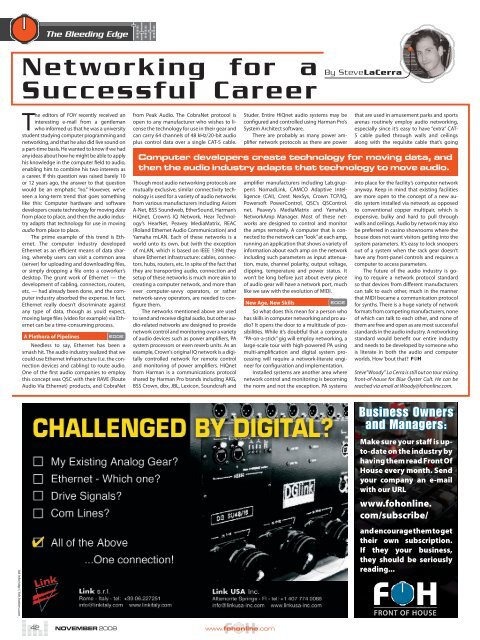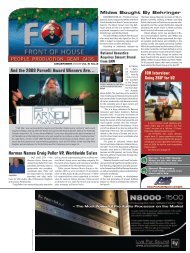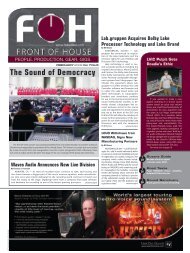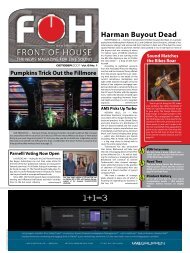You also want an ePaper? Increase the reach of your titles
YUMPU automatically turns print PDFs into web optimized ePapers that Google loves.
Ad info:http:// foh.hotims.com<br />
42<br />
The Bleeding Edge<br />
Networking for a<br />
Successful Career<br />
The editors of <strong>FOH</strong> recently received an<br />
interesting e-mail from a gentleman<br />
who informed us that he was a university<br />
student studying computer programming and<br />
networking, and that he also did live sound on<br />
a part-time basis. He wanted to know if we had<br />
any ideas about how he might be able to apply<br />
his knowledge in the computer field to audio,<br />
enabling him to combine his two interests as<br />
a career. If this question was raised barely 10<br />
or 12 years ago, the answer to that question<br />
would be an emphatic “no.” However, we’ve<br />
seen a long-term trend that goes something<br />
like this: Computer hardware and software<br />
developers create technology for moving data<br />
from place to place, and then the audio industry<br />
adapts that technology for use in moving<br />
audio from place to place.<br />
The prime example of this trend is Ethernet.<br />
The computer industry developed<br />
Ethernet as an efficient means of data sharing,<br />
whereby users can visit a common area<br />
(server) for uploading and downloading files,<br />
or simply dropping a file onto a coworker’s<br />
desktop. The grunt work of Ethernet — the<br />
development of cabling, connectors, routers,<br />
etc. — had already been done, and the computer<br />
industry absorbed the expense. In fact,<br />
Ethernet really doesn’t discriminate against<br />
any type of data, though as you’d expect,<br />
moving large files (video for example) via Ethernet<br />
can be a time-consuming process.<br />
A Plethora of Pipelines EDGE<br />
Needless to say, Ethernet has been a<br />
smash hit. The audio industry realized that we<br />
could use Ethernet infrastructure (i.e. the connection<br />
devices and cabling) to route audio.<br />
One of the first audio companies to employ<br />
this concept was QSC with their RAVE (Route<br />
Audio Via Ethernet) products, and CobraNet<br />
from Peak Audio. The CobraNet protocol is<br />
open to any manufacturer who wishes to license<br />
the technology for use in their gear and<br />
can carry 64 channels of 48 kHz/20-bit audio<br />
plus control data over a single CAT-5 cable.<br />
Though most audio networking protocols are<br />
mutually exclusive, similar connectivity technology<br />
is used for a variety of audio networks<br />
from various manufacturers including Aviom<br />
A-Net, BSS Soundweb, EtherSound, Harman’s<br />
HiQnet, Crown’s IQ Network, Hear Technology’s<br />
HearNet, Peavey MediaMatrix, REAC<br />
(Roland Ethernet Audio Communication) and<br />
Yamaha mLAN. Each of these networks is a<br />
world unto its own, but (with the exception<br />
of mLAN, which is based on IEEE 1394) they<br />
share Ethernet infrastructure: cables, connectors,<br />
hubs, routers, etc. In spite of the fact that<br />
they are transporting audio, connection and<br />
setup of these networks is much more akin to<br />
creating a computer network, and more than<br />
ever computer-savvy operators, or rather<br />
network-savvy operators, are needed to configure<br />
them.<br />
The networks mentioned above are used<br />
to send and receive digital audio, but other audio-related<br />
networks are designed to provide<br />
network control and monitoring over a variety<br />
of audio devices such as power amplifiers, PA<br />
system processors or even reverb units. As an<br />
example, Crown's original IQ network is a digitally<br />
controlled network for remote control<br />
and monitoring of power amplifiers. HiQnet<br />
from Harman is a communications protocol<br />
shared by Harman Pro brands including AKG,<br />
BSS Crown, dbx, JBL, Lexicon, Soundcraft and<br />
NOVEMBER 2008 www.fohonline.com<br />
Studer. Entire HiQnet audio systems may be<br />
configured and controlled using Harman Pro’s<br />
System Architect software.<br />
There are probably as many power amplifier<br />
network protocols as there are power<br />
amplifier manufacturers including Lab.gruppen’s<br />
NomadLink, CAMCO Adaptive Intelligence<br />
(CAI), Crest NexSys, Crown TCP/IQ,<br />
Powersoft PowerControl, QSC’s QSControl.<br />
net, Peavey’s MediaMatrix and Yamaha’s<br />
NetworkAmp Manager. Most of these networks<br />
are designed to control and monitor<br />
the amps remotely. A computer that is connected<br />
to the network can “look” at each amp,<br />
running an application that shows a variety of<br />
information about each amp on the network<br />
including such parameters as input attenuation,<br />
mute, channel polarity, output voltage,<br />
clipping, temperature and power status. It<br />
won’t be long before just about every piece<br />
of audio gear will have a network port, much<br />
like we saw with the evolution of MIDI.<br />
New Age, New Skills EDGE<br />
So what does this mean for a person who<br />
has skills in computer networking and pro audio?<br />
It opens the door to a multitude of possibilities.<br />
While it’s doubtful that a corporate<br />
“PA-on-a-stick” gig will employ networking, a<br />
large-scale tour with high-powered PA using<br />
multi-amplification and digital system processing<br />
will require a network-literate engineer<br />
for configuration and implementation.<br />
Installed systems are another area where<br />
network control and monitoring is becoming<br />
the norm and not the exception. PA systems<br />
By SteveLaCerra<br />
that are used in amusement parks and sports<br />
arenas routinely employ audio networking,<br />
especially since it’s easy to have “extra” CAT-<br />
5 cable pulled through walls and ceilings<br />
along with the requisite cable that’s going<br />
Computer developers create technology for moving data, and<br />
then the audio industry adapts that technology to move audio.<br />
into place for the facility’s computer network<br />
anyway. Keep in mind that existing facilities<br />
are more open to the concept of a new audio<br />
system installed via network as opposed<br />
to conventional copper multipair, which is<br />
expensive, bulky and hard to pull through<br />
walls and ceilings. Audio by network may also<br />
be preferred in casino showrooms where the<br />
house does not want visitors getting into the<br />
system parameters. It’s easy to lock snoopers<br />
out of a system when the rack gear doesn’t<br />
have any front-panel controls and requires a<br />
computer to access parameters.<br />
The future of the audio industry is going<br />
to require a network protocol standard<br />
so that devices from different manufacturers<br />
can talk to each other, much in the manner<br />
that MIDI became a communication protocol<br />
for synths. There is a huge variety of network<br />
formats from competing manufacturers, none<br />
of which can talk to each other, and none of<br />
them are free and open as are most successful<br />
standards in the audio industry. A networking<br />
standard would benefit our entire industry<br />
and needs to be developed by someone who<br />
is literate in both the audio and computer<br />
worlds. How ‘bout that?<br />
Steve”Woody” La Cerra is still out on tour mixing<br />
front-of-house for Blue Öyster Cult. He can be<br />
reached via email at Woody@fohonline.com.<br />
Business Owners<br />
and Managers:<br />
Make sure your staff is upto-date<br />
on the industry by<br />
having them read Front Of<br />
House every month. Send<br />
your company an e-mail<br />
with our URL<br />
www.fohonline.<br />
com/subscribe/<br />
and encourage them to get<br />
their own subscription.<br />
If they your business,<br />
they should be seriously<br />
reading...<br />
www.fohonline.com
















